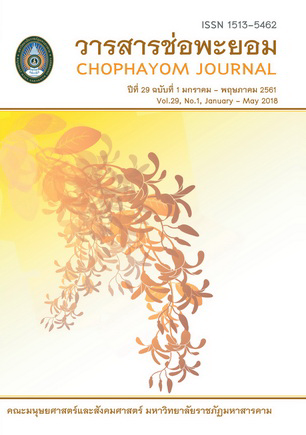รูปแบบการพัฒนาการจัดการขยะของประชาชน จังหวัดบุรีรัมย์ A Model for Garbage Management of People in Buriram Province
Abstract
บทคัดย่อ
การวิจัยนี้มีวัตถุประสงค์ 1) เพื่อศึกษาปัจจัยที่มีผลต่อการจัดการขยะของประชาชน จังหวัดบุรีรัมย์ 2) เพื่อสร้างรูปแบบการพัฒนา การจัดการขยะของประชาชน และ 3) เพื่อทดลองและประเมินผลการใช้รูปแบบการพัฒนาการจัดการขยะของประชาชน วิธีดำเนินการวิจัยแบ่งเป็น 3 ระยะ คือ ระยะที่ 1 เป็นการศึกษาปัจจัยที่มีผลต่อการจัดการขยะของประชาชน จังหวัดบุรีรัมย์ ประชากร คือ ประชาชนในจังหวัดบุรีรัมย์ กำหนดกลุ่มตัวอย่างของ Taro Yamane จำนวน 400 คน ใช้วิธีการสุ่มแบบแบ่งชั้น เครื่องมือที่ใช้คือ แบบสอบถาม วิเคราะห์ข้อมูลใช้สถิติการวิเคราะห์การถดถอยพหุคูณเชิงเส้นตรง (Multiple Linear Regression) กำหนดค่านัยสำคัญทางสถิติที่ระดับ .05 ตัวแปรสาเหตุ จำนวน 4 ปัจจัยสาเหตุ ระยะที่ 2 เป็นการสร้างรูปแบบการพัฒนาการจัดการขยะ ของประชาชน กลุ่มเป้าหมาย จำนวน 30 คน ได้แก่ ผู้บริหารองค์การบริหารส่วนท้องถิ่น จำนวน 10 คน นักวิชาการสาธารณสุข จำนวน 5 คน ผู้บริหารหรือผู้แทนจากกระทรวงมหาดไทย จำนวน 5 คน และผู้มีส่วนได้เสียเกี่ยวกับการจัดการขยะของชุมชน จำนวน 10 คน ใช้วิธีการเลือกแบบเจาะจง โดยใช้ตัวแปรที่มีนัยสำคัญทางสถิติที่ระดับ .05 ที่ได้จากการวิจัยในระยะที่ 1 มาเป็นประเด็นในการพิจารณาสร้างรูปแบบการพัฒนา เก็บรวบรวมข้อมูลโดยวิธีการประชุมกลุ่มย่อย และการระดมความคิดเห็นในที่ประชุมใหญ่ นำรูปแบบที่ปรับปรุงแก้ไขแล้ว ให้ผู้เชี่ยวชาญ จำนวน 3 ท่าน ประเมินความเหมาะสมของรูปแบบการพัฒนา และระยะที่ 3 เป็นการทดลองใช้และประเมินผลรูปแบบการพัฒนาการจัดการขยะของประชาชน กลุ่มทดลอง คือ ประชาชน ชาวบ้านบุญช่วย ตำบลสะเดา อำเภอพลับพลาชัย จังหวัดบุรีรัมย์ จำนวนทั้งสิ้น 55 คน กลุ่มควบคุม คือ ประชาชน ชาวบ้านเสม็ด ตำบลสะเดา อำเภอพลับพลาชัย จังหวัดบุรีรัมย์ จำนวนทั้งสิ้น 55 คน ใช้การเลือกแบบสมัครใจ ประเมินผลการทดลอง โดยการเปรียบเทียบผลการทดลอง ระหว่างกลุ่มทดลองกับกลุ่มควบคุม สถิติวิเคราะห์ใช้การวิเคราะห์ความแปรปรวน (ร่วม) หลายตัวแปรตาม โดยกำหนดค่าระดับนัยสำคัญทางสถิติที่ระดับ .05 ผลการวิจัยปรากฏ ดังนี้ 1. ปัจจัยที่มีผลต่อการจัดการขยะของประชาชน จังหวัดบุรีรัมย์ ประกอบด้วย ด้านการประเมินผล (0.843) ด้านการได้รับผลประโยชน์ (0.236) และด้านการตัดสินใจ (0.086) 2. ผลการสร้างรูปแบบการพัฒนาการจัดการขยะของประชาชน ได้กิจกรรมการพัฒนา 3 ตัวแปร จำนวน 7 กิจกรรม ประกอบดว้ ย 1) การจัดการขยะอยา่ งเปน็ ระบบ 2) ศึกษาดูงาน 3) เปลี่ยนขยะเปน็ ประโยชน์ 4) เปลี่ยนขยะเป็นรายได้ 5) ขยะคือคุณค่าของชีวิต 6) ขยะต้นทาง และ 7) ตั้งกลุ่มจัดการขยะ 3. ผลการทดลองใช้และประเมินผลการใช้รูปแบบการพัฒนาการจัดการขยะของประชาชน จังหวัดบุรีรัมย์ พบว่า หลังการทดลอง กลุ่มทดลอง มีการจัดการขยะ ดีขึ้นกว่ากลุ่มควบคุม และผลการวิเคราะห์ทางสถิติ พบว่า ค่าเฉลี่ยคะแนนในทุกตัวแปรตามของกลุ่มทดลองกับกลุ่มควบคุม แตกต่างกันอย่างมีนัยสำคัญทางสถิติที่ระดับ .05 คำสำคัญ : รูปแบบการพัฒนา, การจัดการขยะ
ABSTRACT
The purposes of research were to (1) analyze causal factors affecting garbage management of people in Buriram province, (2) to design a model for garbage management and (3) to implement and evaluate the model. The researcher methodology was divides into 3 phases. In the first phase, the research investigated and analyzed 4 causal factors which affected garbage management of people in Buriram province. The data was collected by questionnaire from 400 people in Buriram province. Taro Yamane method was used to calculate the sample size and they were selected by the proportional stratified random sampling. The data was analyzed with multiple linear regressions at the .05 level of statistical significance. In the second phase, the researches designed and develop a model for garbage management based on the data of first phase. The model for garbage management was assessed by 30 research participants consisting of ten administrators of Local administrative organizations, five academicians public health, five ministry of interior agent, and ten garbage stakeholders. The data was collected by Workshop, focus group and Brain Storming. In the third phase, the voluntary sample subjects were one hundred and ten people in Buriram province. They were divided into two groups : experimental people by Ban Boonchuy Tumbol Sadoa Plubplachai District Buriram Province and controlled people by Ban Samed Tumbol Sadoa Plubplachai District Buriram Province. The data was analyzed by Multivariate Analysis of Covariance: MANCOVA at the .05 level of statistical significance. Results of the research were as follows: 1. The research findings showed that the three major causal factors were related to garbage management at the .05 level of the statistical significance. The causal factors consisted of 1) Evaluation (0.843), 2) Benefit (0.236), and 3) Resolving (0.086) respectively.
2. A model for garbage management consisted of seven activities: 1) Garbage system, 2) Field Trip, 3) Change for used, 4) Change for money, 5) Garbage for life, 6) Birth garbage, and 7) Garbage group. 3. Finally, the overall garbage management of the experimental was better than that of the controlled in comparison, with the controlled, and the overall variables in garbage management of the experimental and the controlled were different at the .05 level of statistical significance. Keyword : a model, garbage management






